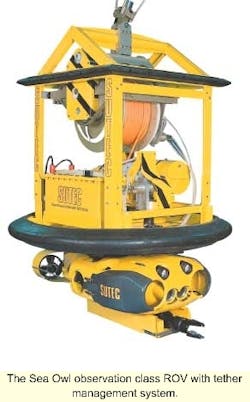REMOTELY OPERATED VEHICLES: 360-degree capability boosts North Sea underwater vehicle
The unique gyro stabilizing system fitted to the Sea Owl IV observation and light work class ROV is thought to have been a factor in its recent selection by Oceaneering for use in the North Sea. This electric ROV, delivered to Oceaneering earlier this year by Saab Bofors Underwater Systems, is capable of a wide range of observation or light work tasks. With a weight in air of 100 kg and the ability to carry a 12 kg payload, the vehicle can work in depths down to 500 meters. Bofors Underwater Systems is currently working on the development of a titanium pressure hull to upgrade the Sea Owl's depth rating to 1,500 meters.
Oceaneering capability
The Sea Owl Mk IV chosen by Oceaneering was supplied with a control console and Bofors' unique 360-degree ROV control system. When in use, the system allows the pilot to carefully control the rate at which the vehicle turns and also its attitude in the water. If the controls are then released by the pilot, the vehicle will retain its attitude and position indefinitely. This is said to make the Sea Owl ideal for performing difficult maneuvers or work assignments in confined spaces. It is particularly helpful when the vehicle is being used to obtain video or sonar images.
The use of dependable brushless electric motors is an important factor in the ROV's operational reliability and efficiency. The motors are said to make it possible for the vehicle's thrusters to run continuously on full power for over 1,000 hours if required. The smooth hydrodynamic shape of the vehicle is an additional benefit that has been developed to reduce the likelihood of the ROV snagging when operating in confined spaces.
Torpedo technology
Oceaneering's expertise has been applied to the development of a torque tool for the Sea Owl that enables it to operate most normal subsea valves. Tools available include a wire cutter, wire attachment, and ma n ip u lators. But, according to Sven-Inge Svensson, Program Manager for Bofors ROVs, the vehicle's maneuverability makes it more versatile than competing ROVs.
Much of the technical expertise that has gone into the development of the Sea Owl and the other Bofors ROVs - the Sea Twin MkII and the Double Eagle - originates from the company meeting the extreme demands and operating requirements of the world's navies. As part of the giant Saab group of companies, Bofors Underwater Systems has access to a wide range of advanced technical resources and makes a substantial investment in research, development, and technical facilities.
Test center
One of the company's principal assets is the establishment it occupies on the shores of Lake Vattern in central Sweden. Easy access to the water for trials has proved a major asset on numerous occasions. Just a short distance from the plant, the lake is 30 meters deep, but further south it reaches 130 meters, deep enough for equipment trials. The technical staff also makes extensive use of a large test tank within their workshop. With a diameter of 10 meters and depth of 6 meters, the tank allows comprehensive in-water trials to be conducted.
Saab Bofors Underwater Systems has been building ROVs since the 1980s, and now has over 130 with predominantly civilian customers around the world. However, the company's experience of underwater technology dates back to 1910, when it began manufacturing a wide range of underwater products for the world's navies. Torpedo production was dominant for some time, but this has expanded to include mines and mine sweeping technology, underwater data acquisition, and the wealth of underwater navigation, guidance, sensory, and communications techniques needed for such products. Earlier, AUVs (autonomous underwater vehicles) were also designed and manufactured for submarine training exercises and the company is now developing AUVs derived from its existing torpedoes.
For more information, contact Sven-Inge Svensson, Saab Bofors Underwater Systems. Tel: +46 141 22 47 50, Fax: +46 141 22 44 59, Email: [email protected].


